Analyzing the Impact of Diversity on Organizational Performance Report
VerifiedAdded on 2020/05/11
|7
|2033
|381
Report
AI Summary
This report presents the results and discussion of a study examining the impact of workforce diversity on organizational performance. The research tested five hypotheses using regression and correlation analysis. The findings indicate a significant relationship between diverse colleagues and organizational performance, although the regression coefficient was negative. Awareness of diversity in the workplace was found to positively impact performance. Age diversity also showed a positive correlation with both employee and organizational performance, highlighting the importance of experience exchange and coordination among employees of different age groups. Furthermore, the study confirmed that educational background significantly influences organizational performance. The research provides practical insights for organizations to manage diversity effectively and offers academic contributions to the existing literature. The study acknowledges limitations such as sample size and variable selection, suggesting areas for future research with larger samples and broader variables, as well as exploring different industries and techniques.
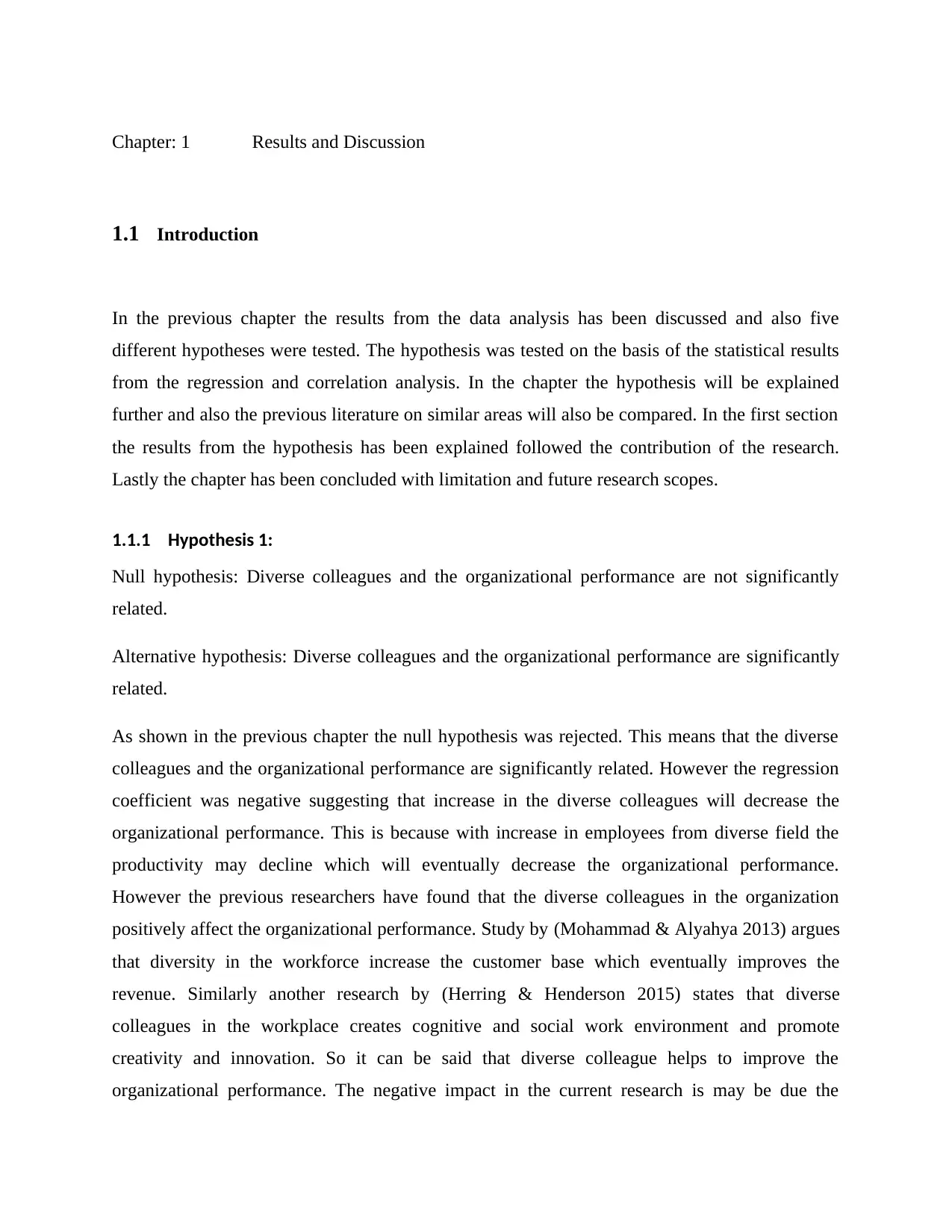
Chapter: 1 Results and Discussion
1.1 Introduction
In the previous chapter the results from the data analysis has been discussed and also five
different hypotheses were tested. The hypothesis was tested on the basis of the statistical results
from the regression and correlation analysis. In the chapter the hypothesis will be explained
further and also the previous literature on similar areas will also be compared. In the first section
the results from the hypothesis has been explained followed the contribution of the research.
Lastly the chapter has been concluded with limitation and future research scopes.
1.1.1 Hypothesis 1:
Null hypothesis: Diverse colleagues and the organizational performance are not significantly
related.
Alternative hypothesis: Diverse colleagues and the organizational performance are significantly
related.
As shown in the previous chapter the null hypothesis was rejected. This means that the diverse
colleagues and the organizational performance are significantly related. However the regression
coefficient was negative suggesting that increase in the diverse colleagues will decrease the
organizational performance. This is because with increase in employees from diverse field the
productivity may decline which will eventually decrease the organizational performance.
However the previous researchers have found that the diverse colleagues in the organization
positively affect the organizational performance. Study by (Mohammad & Alyahya 2013) argues
that diversity in the workforce increase the customer base which eventually improves the
revenue. Similarly another research by (Herring & Henderson 2015) states that diverse
colleagues in the workplace creates cognitive and social work environment and promote
creativity and innovation. So it can be said that diverse colleague helps to improve the
organizational performance. The negative impact in the current research is may be due the
1.1 Introduction
In the previous chapter the results from the data analysis has been discussed and also five
different hypotheses were tested. The hypothesis was tested on the basis of the statistical results
from the regression and correlation analysis. In the chapter the hypothesis will be explained
further and also the previous literature on similar areas will also be compared. In the first section
the results from the hypothesis has been explained followed the contribution of the research.
Lastly the chapter has been concluded with limitation and future research scopes.
1.1.1 Hypothesis 1:
Null hypothesis: Diverse colleagues and the organizational performance are not significantly
related.
Alternative hypothesis: Diverse colleagues and the organizational performance are significantly
related.
As shown in the previous chapter the null hypothesis was rejected. This means that the diverse
colleagues and the organizational performance are significantly related. However the regression
coefficient was negative suggesting that increase in the diverse colleagues will decrease the
organizational performance. This is because with increase in employees from diverse field the
productivity may decline which will eventually decrease the organizational performance.
However the previous researchers have found that the diverse colleagues in the organization
positively affect the organizational performance. Study by (Mohammad & Alyahya 2013) argues
that diversity in the workforce increase the customer base which eventually improves the
revenue. Similarly another research by (Herring & Henderson 2015) states that diverse
colleagues in the workplace creates cognitive and social work environment and promote
creativity and innovation. So it can be said that diverse colleague helps to improve the
organizational performance. The negative impact in the current research is may be due the
Paraphrase This Document
Need a fresh take? Get an instant paraphrase of this document with our AI Paraphraser
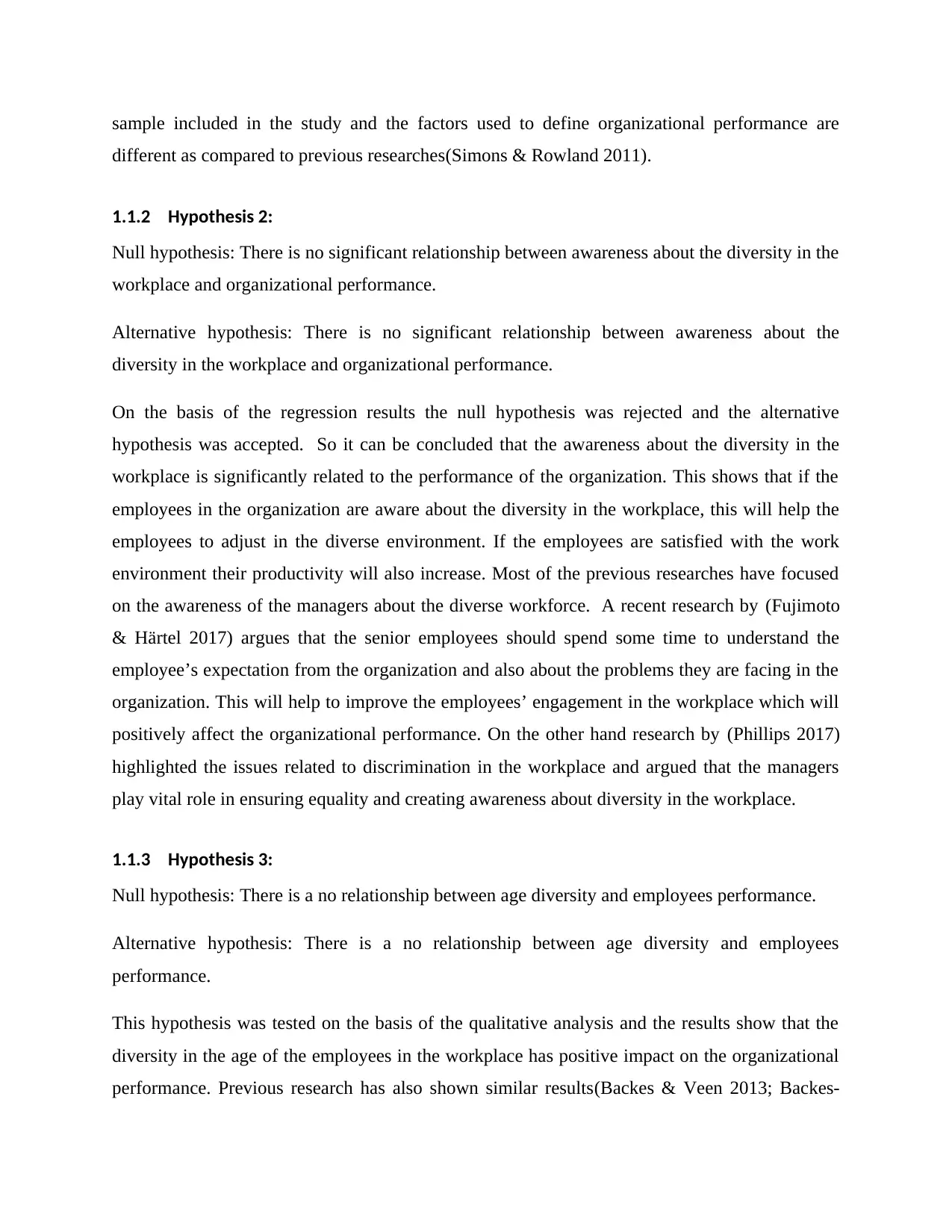
sample included in the study and the factors used to define organizational performance are
different as compared to previous researches(Simons & Rowland 2011).
1.1.2 Hypothesis 2:
Null hypothesis: There is no significant relationship between awareness about the diversity in the
workplace and organizational performance.
Alternative hypothesis: There is no significant relationship between awareness about the
diversity in the workplace and organizational performance.
On the basis of the regression results the null hypothesis was rejected and the alternative
hypothesis was accepted. So it can be concluded that the awareness about the diversity in the
workplace is significantly related to the performance of the organization. This shows that if the
employees in the organization are aware about the diversity in the workplace, this will help the
employees to adjust in the diverse environment. If the employees are satisfied with the work
environment their productivity will also increase. Most of the previous researches have focused
on the awareness of the managers about the diverse workforce. A recent research by (Fujimoto
& Härtel 2017) argues that the senior employees should spend some time to understand the
employee’s expectation from the organization and also about the problems they are facing in the
organization. This will help to improve the employees’ engagement in the workplace which will
positively affect the organizational performance. On the other hand research by (Phillips 2017)
highlighted the issues related to discrimination in the workplace and argued that the managers
play vital role in ensuring equality and creating awareness about diversity in the workplace.
1.1.3 Hypothesis 3:
Null hypothesis: There is a no relationship between age diversity and employees performance.
Alternative hypothesis: There is a no relationship between age diversity and employees
performance.
This hypothesis was tested on the basis of the qualitative analysis and the results show that the
diversity in the age of the employees in the workplace has positive impact on the organizational
performance. Previous research has also shown similar results(Backes & Veen 2013; Backes-
different as compared to previous researches(Simons & Rowland 2011).
1.1.2 Hypothesis 2:
Null hypothesis: There is no significant relationship between awareness about the diversity in the
workplace and organizational performance.
Alternative hypothesis: There is no significant relationship between awareness about the
diversity in the workplace and organizational performance.
On the basis of the regression results the null hypothesis was rejected and the alternative
hypothesis was accepted. So it can be concluded that the awareness about the diversity in the
workplace is significantly related to the performance of the organization. This shows that if the
employees in the organization are aware about the diversity in the workplace, this will help the
employees to adjust in the diverse environment. If the employees are satisfied with the work
environment their productivity will also increase. Most of the previous researches have focused
on the awareness of the managers about the diverse workforce. A recent research by (Fujimoto
& Härtel 2017) argues that the senior employees should spend some time to understand the
employee’s expectation from the organization and also about the problems they are facing in the
organization. This will help to improve the employees’ engagement in the workplace which will
positively affect the organizational performance. On the other hand research by (Phillips 2017)
highlighted the issues related to discrimination in the workplace and argued that the managers
play vital role in ensuring equality and creating awareness about diversity in the workplace.
1.1.3 Hypothesis 3:
Null hypothesis: There is a no relationship between age diversity and employees performance.
Alternative hypothesis: There is a no relationship between age diversity and employees
performance.
This hypothesis was tested on the basis of the qualitative analysis and the results show that the
diversity in the age of the employees in the workplace has positive impact on the organizational
performance. Previous research has also shown similar results(Backes & Veen 2013; Backes-
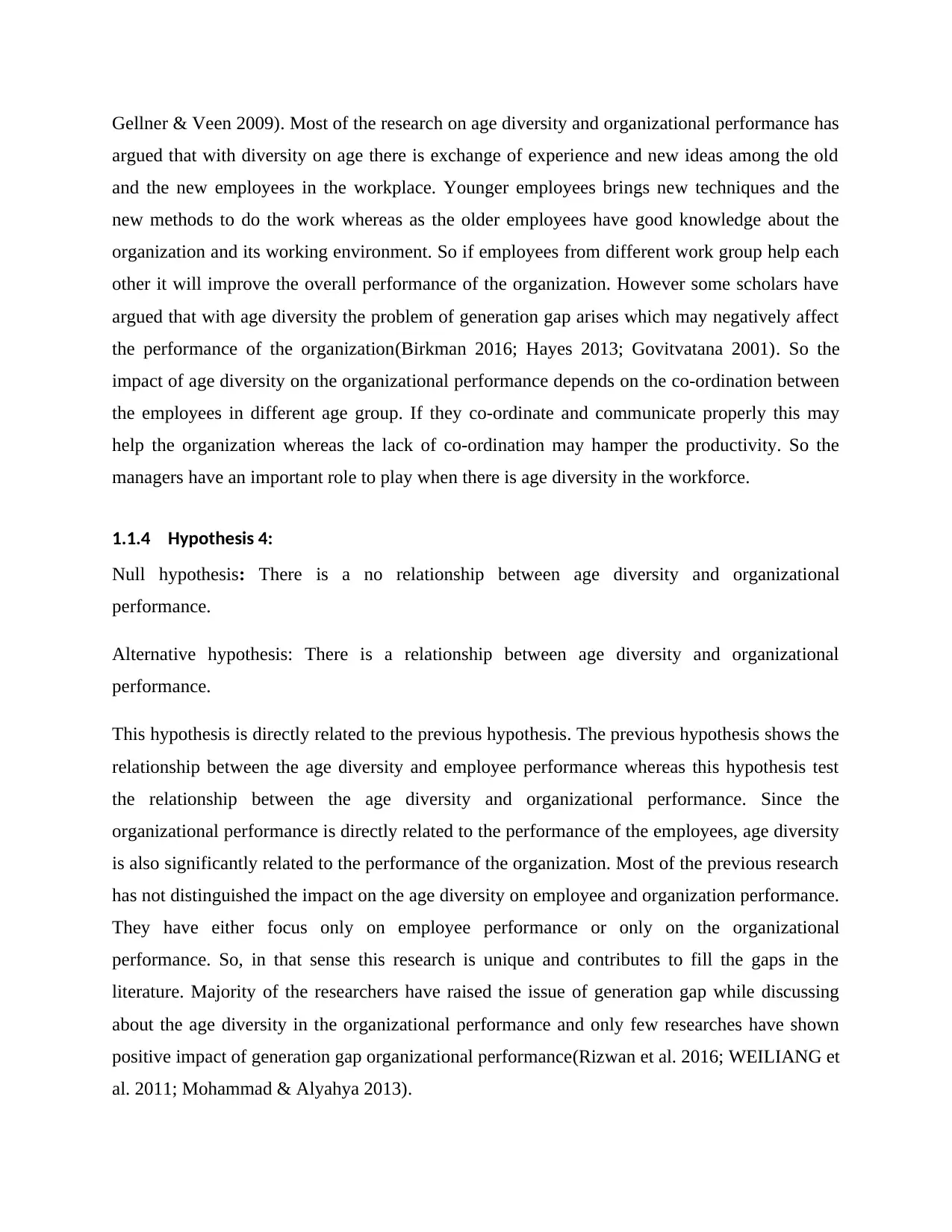
Gellner & Veen 2009). Most of the research on age diversity and organizational performance has
argued that with diversity on age there is exchange of experience and new ideas among the old
and the new employees in the workplace. Younger employees brings new techniques and the
new methods to do the work whereas as the older employees have good knowledge about the
organization and its working environment. So if employees from different work group help each
other it will improve the overall performance of the organization. However some scholars have
argued that with age diversity the problem of generation gap arises which may negatively affect
the performance of the organization(Birkman 2016; Hayes 2013; Govitvatana 2001). So the
impact of age diversity on the organizational performance depends on the co-ordination between
the employees in different age group. If they co-ordinate and communicate properly this may
help the organization whereas the lack of co-ordination may hamper the productivity. So the
managers have an important role to play when there is age diversity in the workforce.
1.1.4 Hypothesis 4:
Null hypothesis: There is a no relationship between age diversity and organizational
performance.
Alternative hypothesis: There is a relationship between age diversity and organizational
performance.
This hypothesis is directly related to the previous hypothesis. The previous hypothesis shows the
relationship between the age diversity and employee performance whereas this hypothesis test
the relationship between the age diversity and organizational performance. Since the
organizational performance is directly related to the performance of the employees, age diversity
is also significantly related to the performance of the organization. Most of the previous research
has not distinguished the impact on the age diversity on employee and organization performance.
They have either focus only on employee performance or only on the organizational
performance. So, in that sense this research is unique and contributes to fill the gaps in the
literature. Majority of the researchers have raised the issue of generation gap while discussing
about the age diversity in the organizational performance and only few researches have shown
positive impact of generation gap organizational performance(Rizwan et al. 2016; WEILIANG et
al. 2011; Mohammad & Alyahya 2013).
argued that with diversity on age there is exchange of experience and new ideas among the old
and the new employees in the workplace. Younger employees brings new techniques and the
new methods to do the work whereas as the older employees have good knowledge about the
organization and its working environment. So if employees from different work group help each
other it will improve the overall performance of the organization. However some scholars have
argued that with age diversity the problem of generation gap arises which may negatively affect
the performance of the organization(Birkman 2016; Hayes 2013; Govitvatana 2001). So the
impact of age diversity on the organizational performance depends on the co-ordination between
the employees in different age group. If they co-ordinate and communicate properly this may
help the organization whereas the lack of co-ordination may hamper the productivity. So the
managers have an important role to play when there is age diversity in the workforce.
1.1.4 Hypothesis 4:
Null hypothesis: There is a no relationship between age diversity and organizational
performance.
Alternative hypothesis: There is a relationship between age diversity and organizational
performance.
This hypothesis is directly related to the previous hypothesis. The previous hypothesis shows the
relationship between the age diversity and employee performance whereas this hypothesis test
the relationship between the age diversity and organizational performance. Since the
organizational performance is directly related to the performance of the employees, age diversity
is also significantly related to the performance of the organization. Most of the previous research
has not distinguished the impact on the age diversity on employee and organization performance.
They have either focus only on employee performance or only on the organizational
performance. So, in that sense this research is unique and contributes to fill the gaps in the
literature. Majority of the researchers have raised the issue of generation gap while discussing
about the age diversity in the organizational performance and only few researches have shown
positive impact of generation gap organizational performance(Rizwan et al. 2016; WEILIANG et
al. 2011; Mohammad & Alyahya 2013).
⊘ This is a preview!⊘
Do you want full access?
Subscribe today to unlock all pages.

Trusted by 1+ million students worldwide
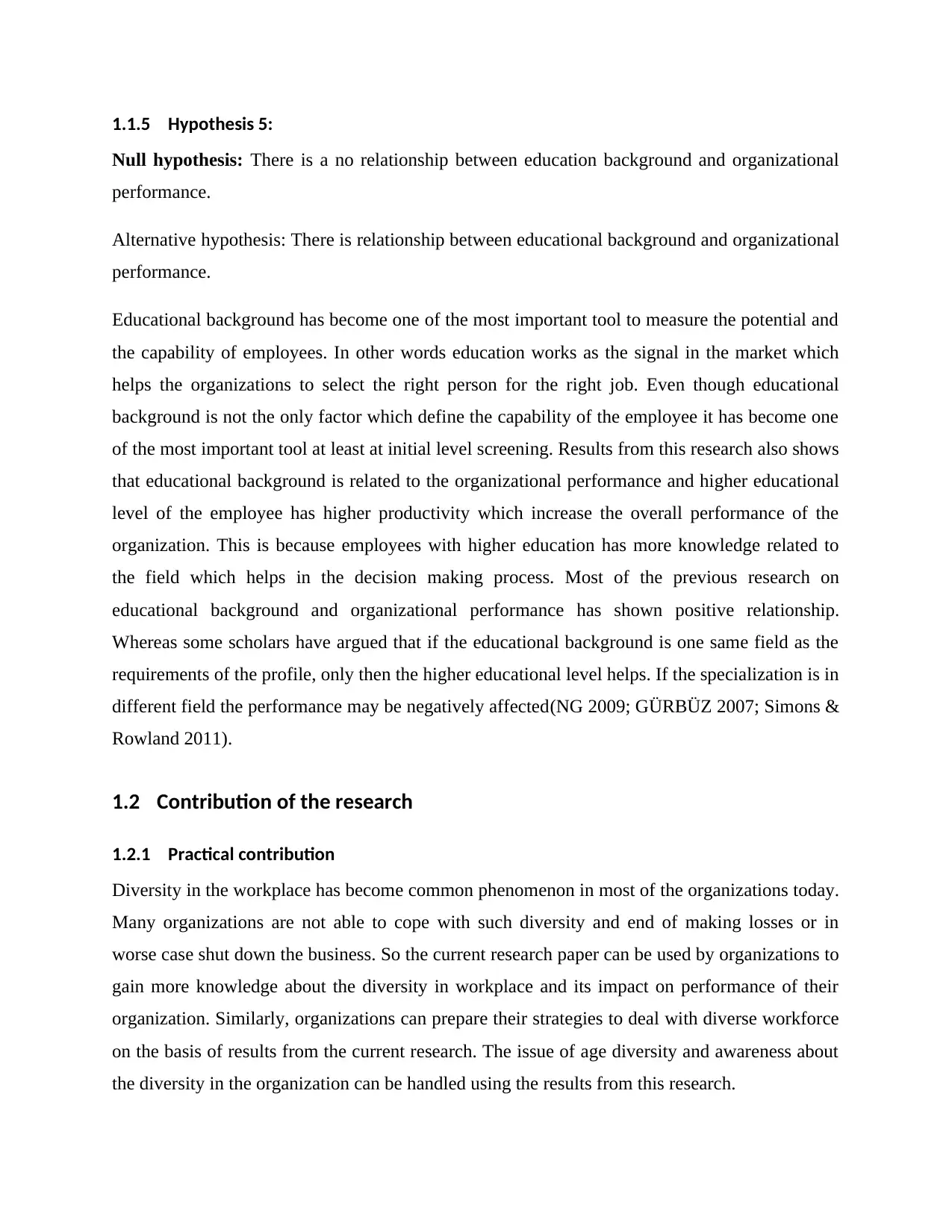
1.1.5 Hypothesis 5:
Null hypothesis: There is a no relationship between education background and organizational
performance.
Alternative hypothesis: There is relationship between educational background and organizational
performance.
Educational background has become one of the most important tool to measure the potential and
the capability of employees. In other words education works as the signal in the market which
helps the organizations to select the right person for the right job. Even though educational
background is not the only factor which define the capability of the employee it has become one
of the most important tool at least at initial level screening. Results from this research also shows
that educational background is related to the organizational performance and higher educational
level of the employee has higher productivity which increase the overall performance of the
organization. This is because employees with higher education has more knowledge related to
the field which helps in the decision making process. Most of the previous research on
educational background and organizational performance has shown positive relationship.
Whereas some scholars have argued that if the educational background is one same field as the
requirements of the profile, only then the higher educational level helps. If the specialization is in
different field the performance may be negatively affected(NG 2009; GÜRBÜZ 2007; Simons &
Rowland 2011).
1.2 Contribution of the research
1.2.1 Practical contribution
Diversity in the workplace has become common phenomenon in most of the organizations today.
Many organizations are not able to cope with such diversity and end of making losses or in
worse case shut down the business. So the current research paper can be used by organizations to
gain more knowledge about the diversity in workplace and its impact on performance of their
organization. Similarly, organizations can prepare their strategies to deal with diverse workforce
on the basis of results from the current research. The issue of age diversity and awareness about
the diversity in the organization can be handled using the results from this research.
Null hypothesis: There is a no relationship between education background and organizational
performance.
Alternative hypothesis: There is relationship between educational background and organizational
performance.
Educational background has become one of the most important tool to measure the potential and
the capability of employees. In other words education works as the signal in the market which
helps the organizations to select the right person for the right job. Even though educational
background is not the only factor which define the capability of the employee it has become one
of the most important tool at least at initial level screening. Results from this research also shows
that educational background is related to the organizational performance and higher educational
level of the employee has higher productivity which increase the overall performance of the
organization. This is because employees with higher education has more knowledge related to
the field which helps in the decision making process. Most of the previous research on
educational background and organizational performance has shown positive relationship.
Whereas some scholars have argued that if the educational background is one same field as the
requirements of the profile, only then the higher educational level helps. If the specialization is in
different field the performance may be negatively affected(NG 2009; GÜRBÜZ 2007; Simons &
Rowland 2011).
1.2 Contribution of the research
1.2.1 Practical contribution
Diversity in the workplace has become common phenomenon in most of the organizations today.
Many organizations are not able to cope with such diversity and end of making losses or in
worse case shut down the business. So the current research paper can be used by organizations to
gain more knowledge about the diversity in workplace and its impact on performance of their
organization. Similarly, organizations can prepare their strategies to deal with diverse workforce
on the basis of results from the current research. The issue of age diversity and awareness about
the diversity in the organization can be handled using the results from this research.
Paraphrase This Document
Need a fresh take? Get an instant paraphrase of this document with our AI Paraphraser
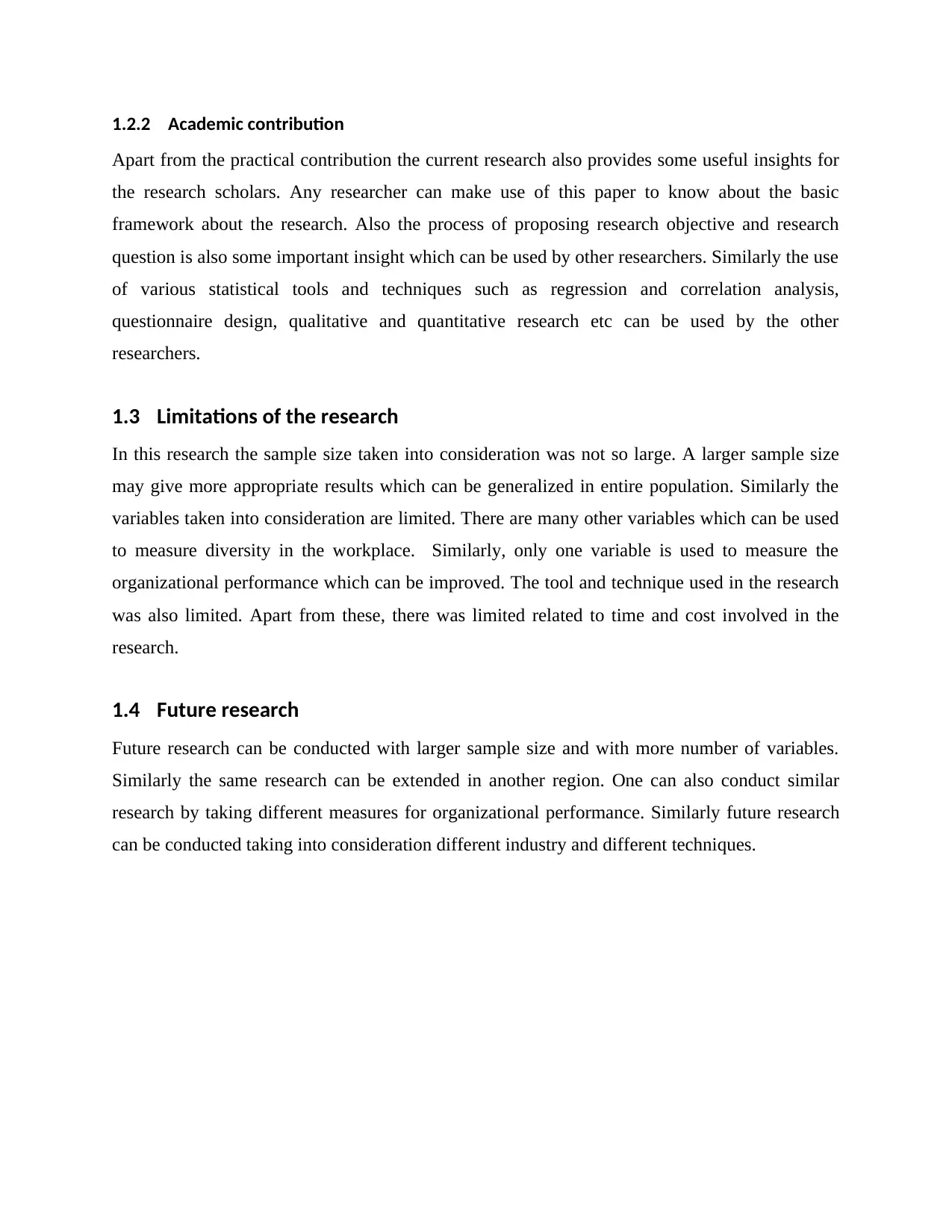
1.2.2 Academic contribution
Apart from the practical contribution the current research also provides some useful insights for
the research scholars. Any researcher can make use of this paper to know about the basic
framework about the research. Also the process of proposing research objective and research
question is also some important insight which can be used by other researchers. Similarly the use
of various statistical tools and techniques such as regression and correlation analysis,
questionnaire design, qualitative and quantitative research etc can be used by the other
researchers.
1.3 Limitations of the research
In this research the sample size taken into consideration was not so large. A larger sample size
may give more appropriate results which can be generalized in entire population. Similarly the
variables taken into consideration are limited. There are many other variables which can be used
to measure diversity in the workplace. Similarly, only one variable is used to measure the
organizational performance which can be improved. The tool and technique used in the research
was also limited. Apart from these, there was limited related to time and cost involved in the
research.
1.4 Future research
Future research can be conducted with larger sample size and with more number of variables.
Similarly the same research can be extended in another region. One can also conduct similar
research by taking different measures for organizational performance. Similarly future research
can be conducted taking into consideration different industry and different techniques.
Apart from the practical contribution the current research also provides some useful insights for
the research scholars. Any researcher can make use of this paper to know about the basic
framework about the research. Also the process of proposing research objective and research
question is also some important insight which can be used by other researchers. Similarly the use
of various statistical tools and techniques such as regression and correlation analysis,
questionnaire design, qualitative and quantitative research etc can be used by the other
researchers.
1.3 Limitations of the research
In this research the sample size taken into consideration was not so large. A larger sample size
may give more appropriate results which can be generalized in entire population. Similarly the
variables taken into consideration are limited. There are many other variables which can be used
to measure diversity in the workplace. Similarly, only one variable is used to measure the
organizational performance which can be improved. The tool and technique used in the research
was also limited. Apart from these, there was limited related to time and cost involved in the
research.
1.4 Future research
Future research can be conducted with larger sample size and with more number of variables.
Similarly the same research can be extended in another region. One can also conduct similar
research by taking different measures for organizational performance. Similarly future research
can be conducted taking into consideration different industry and different techniques.
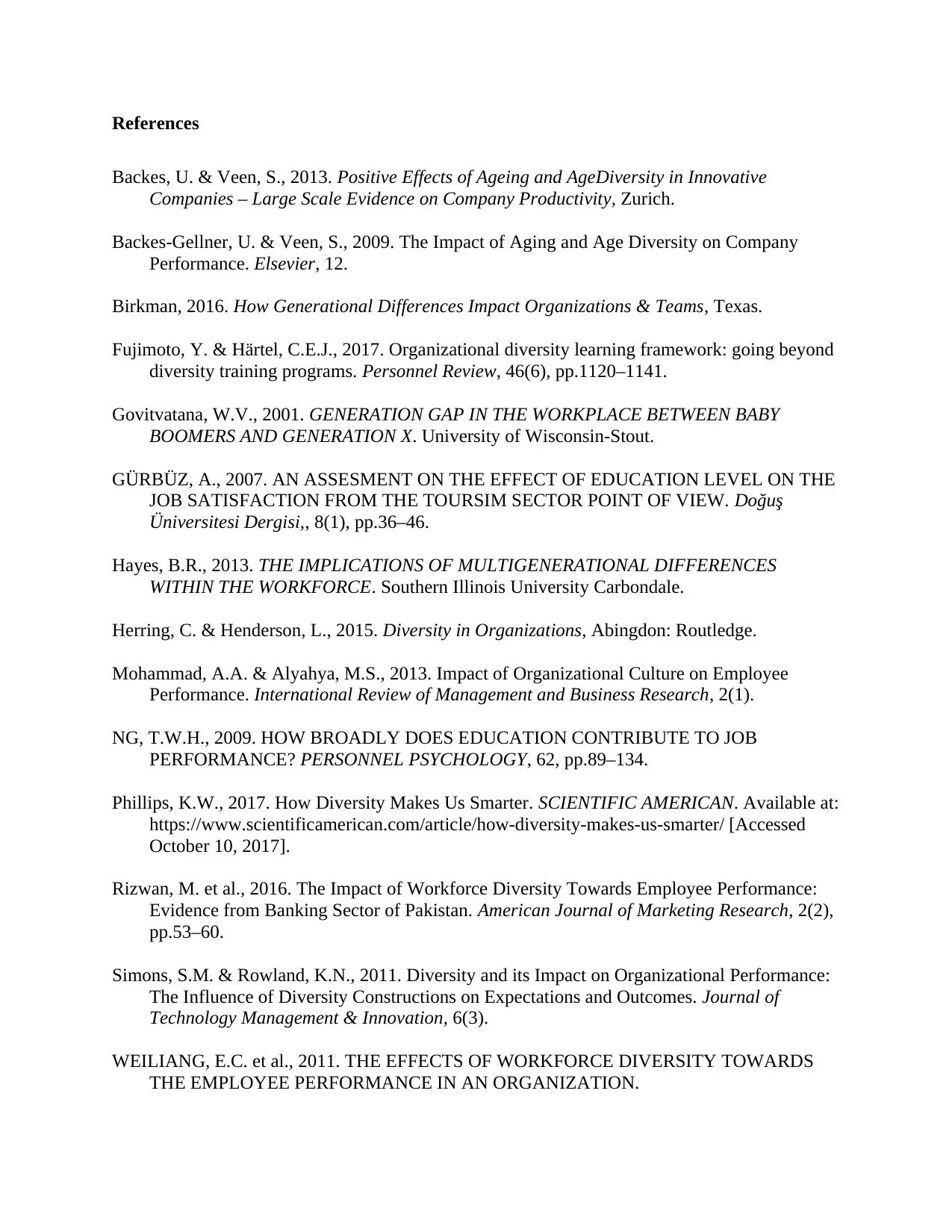
References
Backes, U. & Veen, S., 2013. Positive Effects of Ageing and AgeDiversity in Innovative
Companies – Large Scale Evidence on Company Productivity, Zurich.
Backes-Gellner, U. & Veen, S., 2009. The Impact of Aging and Age Diversity on Company
Performance. Elsevier, 12.
Birkman, 2016. How Generational Differences Impact Organizations & Teams, Texas.
Fujimoto, Y. & Härtel, C.E.J., 2017. Organizational diversity learning framework: going beyond
diversity training programs. Personnel Review, 46(6), pp.1120–1141.
Govitvatana, W.V., 2001. GENERATION GAP IN THE WORKPLACE BETWEEN BABY
BOOMERS AND GENERATION X. University of Wisconsin-Stout.
GÜRBÜZ, A., 2007. AN ASSESMENT ON THE EFFECT OF EDUCATION LEVEL ON THE
JOB SATISFACTION FROM THE TOURSIM SECTOR POINT OF VIEW. Doğuş
Üniversitesi Dergisi,, 8(1), pp.36–46.
Hayes, B.R., 2013. THE IMPLICATIONS OF MULTIGENERATIONAL DIFFERENCES
WITHIN THE WORKFORCE. Southern Illinois University Carbondale.
Herring, C. & Henderson, L., 2015. Diversity in Organizations, Abingdon: Routledge.
Mohammad, A.A. & Alyahya, M.S., 2013. Impact of Organizational Culture on Employee
Performance. International Review of Management and Business Research, 2(1).
NG, T.W.H., 2009. HOW BROADLY DOES EDUCATION CONTRIBUTE TO JOB
PERFORMANCE? PERSONNEL PSYCHOLOGY, 62, pp.89–134.
Phillips, K.W., 2017. How Diversity Makes Us Smarter. SCIENTIFIC AMERICAN. Available at:
https://www.scientificamerican.com/article/how-diversity-makes-us-smarter/ [Accessed
October 10, 2017].
Rizwan, M. et al., 2016. The Impact of Workforce Diversity Towards Employee Performance:
Evidence from Banking Sector of Pakistan. American Journal of Marketing Research, 2(2),
pp.53–60.
Simons, S.M. & Rowland, K.N., 2011. Diversity and its Impact on Organizational Performance:
The Influence of Diversity Constructions on Expectations and Outcomes. Journal of
Technology Management & Innovation, 6(3).
WEILIANG, E.C. et al., 2011. THE EFFECTS OF WORKFORCE DIVERSITY TOWARDS
THE EMPLOYEE PERFORMANCE IN AN ORGANIZATION.
Backes, U. & Veen, S., 2013. Positive Effects of Ageing and AgeDiversity in Innovative
Companies – Large Scale Evidence on Company Productivity, Zurich.
Backes-Gellner, U. & Veen, S., 2009. The Impact of Aging and Age Diversity on Company
Performance. Elsevier, 12.
Birkman, 2016. How Generational Differences Impact Organizations & Teams, Texas.
Fujimoto, Y. & Härtel, C.E.J., 2017. Organizational diversity learning framework: going beyond
diversity training programs. Personnel Review, 46(6), pp.1120–1141.
Govitvatana, W.V., 2001. GENERATION GAP IN THE WORKPLACE BETWEEN BABY
BOOMERS AND GENERATION X. University of Wisconsin-Stout.
GÜRBÜZ, A., 2007. AN ASSESMENT ON THE EFFECT OF EDUCATION LEVEL ON THE
JOB SATISFACTION FROM THE TOURSIM SECTOR POINT OF VIEW. Doğuş
Üniversitesi Dergisi,, 8(1), pp.36–46.
Hayes, B.R., 2013. THE IMPLICATIONS OF MULTIGENERATIONAL DIFFERENCES
WITHIN THE WORKFORCE. Southern Illinois University Carbondale.
Herring, C. & Henderson, L., 2015. Diversity in Organizations, Abingdon: Routledge.
Mohammad, A.A. & Alyahya, M.S., 2013. Impact of Organizational Culture on Employee
Performance. International Review of Management and Business Research, 2(1).
NG, T.W.H., 2009. HOW BROADLY DOES EDUCATION CONTRIBUTE TO JOB
PERFORMANCE? PERSONNEL PSYCHOLOGY, 62, pp.89–134.
Phillips, K.W., 2017. How Diversity Makes Us Smarter. SCIENTIFIC AMERICAN. Available at:
https://www.scientificamerican.com/article/how-diversity-makes-us-smarter/ [Accessed
October 10, 2017].
Rizwan, M. et al., 2016. The Impact of Workforce Diversity Towards Employee Performance:
Evidence from Banking Sector of Pakistan. American Journal of Marketing Research, 2(2),
pp.53–60.
Simons, S.M. & Rowland, K.N., 2011. Diversity and its Impact on Organizational Performance:
The Influence of Diversity Constructions on Expectations and Outcomes. Journal of
Technology Management & Innovation, 6(3).
WEILIANG, E.C. et al., 2011. THE EFFECTS OF WORKFORCE DIVERSITY TOWARDS
THE EMPLOYEE PERFORMANCE IN AN ORGANIZATION.
⊘ This is a preview!⊘
Do you want full access?
Subscribe today to unlock all pages.

Trusted by 1+ million students worldwide

1 out of 7
Related Documents
Your All-in-One AI-Powered Toolkit for Academic Success.
+13062052269
info@desklib.com
Available 24*7 on WhatsApp / Email
![[object Object]](/_next/static/media/star-bottom.7253800d.svg)
Unlock your academic potential
Copyright © 2020–2025 A2Z Services. All Rights Reserved. Developed and managed by ZUCOL.





